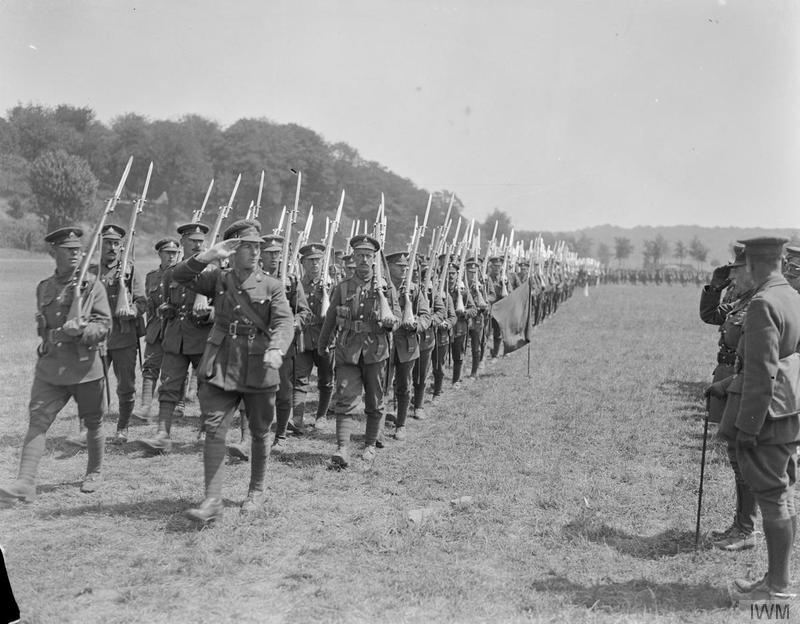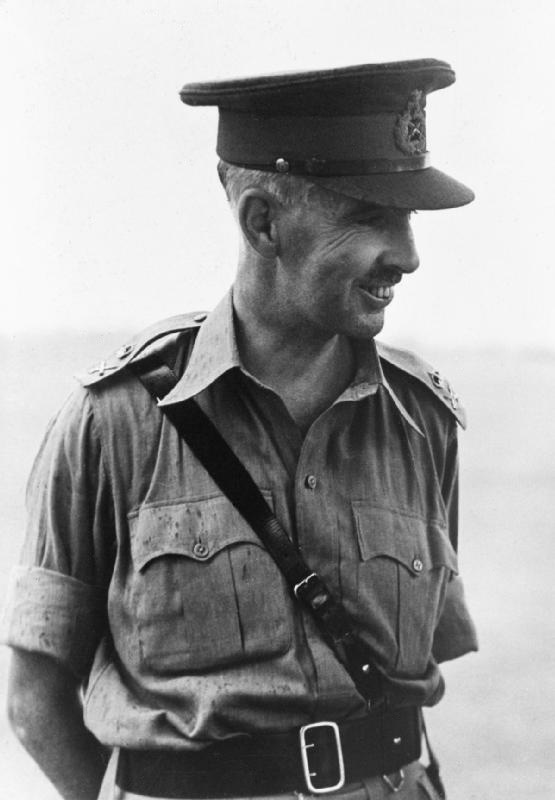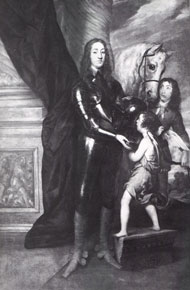|
219th Independent Infantry Brigade
The 219th Brigade was a Home Service formation of the British Army during the First and the Second World Wars. First World War Formation and Service The 219th Brigade was raised in late 1916 as part of 73rd Division, which had the dual role of training men for overseas drafts and providing forces for home defence. 73 Division assembled around Blackpool and then in January 1917 moved to Hertfordshire and Essex to join Southern Army (Home Forces). 219 Brigade was stationed at Danbury and Maldon in Essex, moving to Southend in October. Its role was training, particularly in improving the physique of the men who were being prepared for active service. On 21 December 1917 orders were issued to break up 73rd Division. Disbandment began in January 1918 and its last elements disappeared on 8 April 1918. Order of Battle The following infantry battalions served in the brigade:Becke, pp. 111–6. *8th (Home Service) Battalion, Dorsetshire Regiment, disbanded by 3 December 1917. *13 ... [...More Info...] [...Related Items...] OR: [Wikipedia] [Google] [Baidu] |
Flag Of The British Army
A flag is a piece of fabric (most often rectangular or quadrilateral) with a distinctive design and colours. It is used as a symbol, a signalling device, or for decoration. The term ''flag'' is also used to refer to the graphic design employed, and flags have evolved into a general tool for rudimentary signalling and identification, especially in environments where communication is challenging (such as the maritime environment, where semaphore is used). Many flags fall into groups of similar designs called flag families. The study of flags is known as "vexillology" from the Latin , meaning "flag" or "banner". National flags are patriotic symbols with widely varied interpretations that often include strong military associations because of their original and ongoing use for that purpose. Flags are also used in messaging, advertising, or for decorative purposes. Some military units are called "flags" after their use of flags. A ''flag'' (Arabic: ) is equivalent to a brigade ... [...More Info...] [...Related Items...] OR: [Wikipedia] [Google] [Baidu] |
United Kingdom
The United Kingdom of Great Britain and Northern Ireland, commonly known as the United Kingdom (UK) or Britain, is a country in Europe, off the north-western coast of the continental mainland. It comprises England, Scotland, Wales and Northern Ireland. The United Kingdom includes the island of Great Britain, the north-eastern part of the island of Ireland, and many smaller islands within the British Isles. Northern Ireland shares a land border with the Republic of Ireland; otherwise, the United Kingdom is surrounded by the Atlantic Ocean, the North Sea, the English Channel, the Celtic Sea and the Irish Sea. The total area of the United Kingdom is , with an estimated 2020 population of more than 67 million people. The United Kingdom has evolved from a series of annexations, unions and separations of constituent countries over several hundred years. The Treaty of Union between the Kingdom of England (which included Wales, annexed in 1542) and the Kingdom of Scotland in 170 ... [...More Info...] [...Related Items...] OR: [Wikipedia] [Google] [Baidu] |
10th Medium Regiment, Royal Artillery
The 10th (Royal Fusiliers) Medium Regiment, Royal Artillery, was a WW2 formed Medium Artillery regiment, enabled on 11 December 1942. The regiment was a conversion of the 16th Battalion, The Royal Fusiliers (City of London Regiment), which was part of 47th London Division. The conversion took place while the regiment was engaged in guarding the port and defences of Dover, Kent. The whole battalion moved to the North of England (Durham) and was joined by a number of OR's from the Royal Welsh Fusiliers, Gunnery Officers & NCO's from the regular army's 65th (Highland) Medium Regiment RA, to make up the War Establishment. The regiment was formed into two Batteries, 83 and 84, consisting of four 'Troops' (a/b and c/d), each with four guns - a total of 16 guns for the regiment. The regiment subsequently came under command of the newly formed 9AGRA (Army Group Royal Artillery) along with: *9th Medium Regiment RA *11th Medium Regiment RA *107th Medium Regiment RA *146th Medium Regiment RA ... [...More Info...] [...Related Items...] OR: [Wikipedia] [Google] [Baidu] |
Royal Fusiliers
The Royal Fusiliers (City of London Regiment) was a line infantry regiment of the British Army in continuous existence for 283 years. It was known as the 7th Regiment of Foot until the Childers Reforms of 1881. The regiment served in many wars and conflicts throughout its long existence, including the Second Boer War, the First World War and the Second World War. In 1968, the regiment was amalgamated with the other regiments of the Fusilier Brigade – the Royal Northumberland Fusiliers, the Royal Warwickshire Fusiliers and the Lancashire Fusiliers – to form a new large regiment, the Royal Regiment of Fusiliers. The Royal Fusiliers War Memorial, a monument dedicated to the almost 22,000 Royal Fusiliers who died during the First World War, stands on Holborn in the City of London. History Formation It was formed as a fusilier regiment in 1685 by George Legge, 1st Baron Dartmouth, from two companies of the Tower of London guard, and was originally called the Ordnance Regiment ... [...More Info...] [...Related Items...] OR: [Wikipedia] [Google] [Baidu] |
Royal Sussex Regiment
The Royal Sussex Regiment was a line infantry regiment of the British Army that was in existence from 1881 to 1966. The regiment was formed in 1881 as part of the Childers Reforms by the amalgamation of the 35th (Royal Sussex) Regiment of Foot and the 107th Regiment of Foot (Bengal Light Infantry). The regiment saw service in the Second Boer War, and both World War I and World War II. On 31 December 1966, the Royal Sussex Regiment was amalgamated with the other regiments of the Home Counties Brigade – the Queen's Royal Surrey Regiment, the Queen's Own Buffs, The Royal Kent Regiment, and the Middlesex Regiment (Duke of Cambridge's Own) – to form the Queen's Regiment; which was later, on 9 September 1992, amalgamated with the Royal Hampshire Regiment to form the present Princess of Wales's Royal Regiment (Queen's and Royal Hampshires). History 1881–1914 The regiment was formed in 1881 as part of the Childers Reforms by the amalgamation of the 35th (Royal Sussex) Regi ... [...More Info...] [...Related Items...] OR: [Wikipedia] [Google] [Baidu] |
Malayan Campaign
The Malayan campaign, referred to by Japanese sources as the , was a military campaign fought by Allied and Axis forces in Malaya, from 8 December 1941 – 15 February 1942 during the Second World War. It was dominated by land battles between British Commonwealth army units and the Imperial Japanese Army, with minor skirmishes at the beginning of the campaign between British Commonwealth and Royal Thai Police. The Japanese had air and naval supremacy from the opening days of the campaign. For the British, Indian, Australian, and Malayan forces defending the colony, the campaign was a total disaster. The operation is notable for the Japanese use of bicycle infantry, which allowed troops to carry more equipment and swiftly move through thick jungle terrain. Royal Engineers, equipped with demolition charges, destroyed over a hundred bridges during the retreat, yet this did little to delay the Japanese. By the time the Japanese had captured Singapore, they had suffered 9,657 cas ... [...More Info...] [...Related Items...] OR: [Wikipedia] [Google] [Baidu] |
East Surrey Regiment
The East Surrey Regiment was a line infantry regiment of the British Army in existence from 1881 until 1959. The regiment was formed in 1881 under the Childers Reforms by the amalgamation of the 31st (Huntingdonshire) Regiment of Foot, the 70th (Surrey) Regiment of Foot, the 1st Royal Surrey Militia and the 3rd Royal Surrey Militia. In 1959, after service in the Second Boer War and both World War I and World War II, the East Surrey Regiment was amalgamated with the Queen's Royal Regiment (West Surrey) to form the Queen's Royal Surrey Regiment, which was, in 1966, merged with the Queen's Own Buffs, The Royal Kent Regiment, the Royal Sussex Regiment and the Middlesex Regiment (Duke of Cambridge's Own) to form the Queen's Regiment. The Queen's Regiment was subsequently amalgamated with the Royal Hampshire Regiment to form the present Princess of Wales's Royal Regiment (Queen's and Royal Hampshires). History Early history In 1702 a regiment of marines was raised in the West Countr ... [...More Info...] [...Related Items...] OR: [Wikipedia] [Google] [Baidu] |
89th Light Anti-Aircraft Regiment, Royal Artillery
The 89th Light Anti-Aircraft Regiment, Royal Artillery, (89th LAA Rgt) was an air defence unit of the British Army during World War II. Initially raised as an infantry battalion of the Buffs in 1940, it transferred to the Royal Artillery in 1941. It served with 49th (West Riding) Infantry Division in Normandy (Operation Overlord) and through the campaign in North West Europe until VE Day. 11th Battalion, Buffs (Royal East Kent Regiment) The unit was originally formed in January 1940 as a company of 14th (Holding) Battalion at Tonbridge in Kent, as part of the rapid expansion of the Army with wartime conscripts. When 14th (H) Battalion was disbanded on 28 May 1940, the company was expanded into 50th Holding Battalion, Buffs (Royal East Kent Regiment), and converted to a normal infantry battalion on 9 October that year as 11th Battalion, Buffs.Frederick, p. 208. On 26 October it joined 219th Independent Infantry Brigade (Home) which was being organised as a static defence formati ... [...More Info...] [...Related Items...] OR: [Wikipedia] [Google] [Baidu] |
11th Battalion, Buffs (Royal East Kent Regiment)
The 89th Light Anti-Aircraft Regiment, Royal Artillery, (89th LAA Rgt) was an air defence unit of the British Army during World War II. Initially raised as an infantry battalion of the Buffs in 1940, it transferred to the Royal Artillery in 1941. It served with 49th (West Riding) Infantry Division in Normandy (Operation Overlord) and through the campaign in North West Europe until VE Day. 11th Battalion, Buffs (Royal East Kent Regiment) The unit was originally formed in January 1940 as a company of 14th (Holding) Battalion at Tonbridge in Kent, as part of the rapid expansion of the Army with wartime conscripts. When 14th (H) Battalion was disbanded on 28 May 1940, the company was expanded into 50th Holding Battalion, Buffs (Royal East Kent Regiment), and converted to a normal infantry battalion on 9 October that year as 11th Battalion, Buffs.Frederick, p. 208. On 26 October it joined 219th Independent Infantry Brigade (Home) which was being organised as a static defence formati ... [...More Info...] [...Related Items...] OR: [Wikipedia] [Google] [Baidu] |
Queen's Royal Regiment (West Surrey)
The Queen's Royal Regiment (West Surrey) was a line infantry regiment of the English and later the British Army from 1661 to 1959. It was the senior English line infantry regiment of the British Army, behind only the Royal Scots in the British Army line infantry List of Regiments of Foot, order of precedence. In 1959, the regiment was amalgamated with the East Surrey Regiment, to form a single county regiment called the Queen's Royal Surrey Regiment which was, on 31 December 1966, amalgamated with the Queen's Own Buffs, The Royal Kent Regiment, the Royal Sussex Regiment and the Middlesex Regiment, Middlesex Regiment (Duke of Cambridge's Own) to form the Queen's Regiment. Following a further amalgamation in 1992 with the Royal Hampshire Regiment, the lineage of the regiment is continued today by the Princess of Wales's Royal Regiment, Princess of Wales's Royal Regiment (Queen's and Royal Hampshires). Titles The regiment was raised in 1661 by Henry Mordaunt, 2nd Earl of Peterboroug ... [...More Info...] [...Related Items...] OR: [Wikipedia] [Google] [Baidu] |
Royal Artillery
The Royal Regiment of Artillery, commonly referred to as the Royal Artillery (RA) and colloquially known as "The Gunners", is one of two regiments that make up the artillery arm of the British Army. The Royal Regiment of Artillery comprises thirteen Regular Army regiments, the King's Troop Royal Horse Artillery and five Army Reserve regiments. History Formation to 1799 Artillery was used by the English army as early as the Battle of Crécy in 1346, while Henry VIII established it as a semi-permanent function in the 16th century. Until the early 18th century, the majority of British regiments were raised for specific campaigns and disbanded on completion. An exception were gunners based at the Tower of London, Portsmouth and other forts around Britain, who were controlled by the Ordnance Office and stored and maintained equipment and provided personnel for field artillery 'traynes' that were organised as needed. These personnel, responsible in peacetime for maintaining the ... [...More Info...] [...Related Items...] OR: [Wikipedia] [Google] [Baidu] |
44th (Home Counties) Division
The Home Counties Division was an infantry division of the Territorial Force, part of the British Army, that was raised in 1908. As the name suggests, the division recruited in the Home Counties, particularly Kent, Middlesex, Surrey and Sussex. At the outbreak of the First World War, it accepted liability for overseas service and was posted to India in 1914 to relieve Regular Army units for service on the Western Front. On arrival in India it was effectively broken up, so it did not see active service as a complete formation. However, most of its constituent units did serve in active theatres, notably Mesopotamia from 1915 and in the Third Anglo-Afghan War in 1919. Reformed in the Territorial Army (TA) in 1920 as the 44th (Home Counties) Division, the division saw active service in the Second World War in Belgium, France and North Africa (notably in the Battle of El Alamein) before again being disbanded in 1943. Once again, its component units continued to serve, in North Afric ... [...More Info...] [...Related Items...] OR: [Wikipedia] [Google] [Baidu] |





_Cap_Badge.jpg)

